Note. This is a complex procedure, and before starting work, you should carefully read the contents of the paragraph. For ease of installation, before removing, mark the installation position of the appropriate brackets and the routing of hoses, wires and cables.
Removing
1. Disconnect the ground wire from the battery (see «Disconnecting the battery»).
2. Drain the coolant from the cooling system as described in chapter 1B.
3. Remove the intake and exhaust manifolds as described in chapter 4B.
4. Release the clamp and disconnect the vacuum hose from the vacuum pump of the brake system (pic. 13.4).
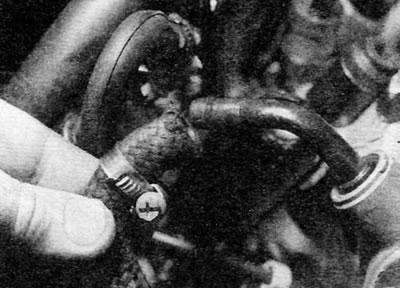
Pic. 13.4. Disconnecting the vacuum hose from the vacuum pump of the brake system
5. Disconnect and remove fuel injector return hoses (pic. 13.5).
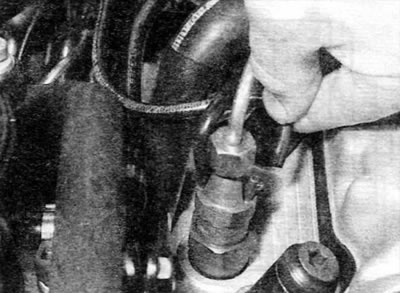
Pic. 13.5. Disconnecting the fuel injector return hose
6. Disconnect the fuel lines from the fuel injectors and high pressure fuel pump and remove the fuel lines as described in chapter 4B.
7. Turn away a nut and disconnect a feeding wire from a corresponding incandescent candle. Remove washers.
8. Disconnect the coolant hose from the rear of the cylinder head on the left side (pic. 13.8).
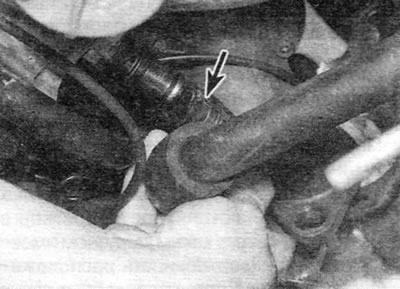
Pic. 13.8. Disconnecting the coolant hose (marked with an arrow) from the rear of the cylinder head
9. Disconnect the small coolant hose from the front of the cylinder head on the side of the timing belt (pic. 13.9).
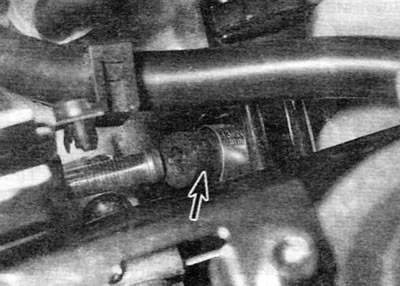
Pic. 13.9. Disconnecting the coolant hose (marked with an arrow) from the front of the cylinder head
10. Release the fuel return hose from the brackets on the cylinder head and move it to the side (pic. 13.10).
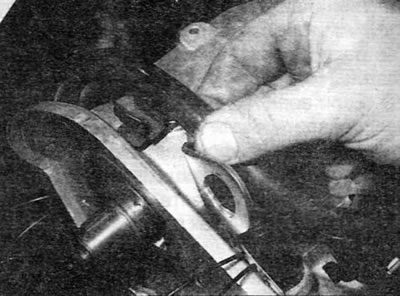
Pic. 13.10. release the fuel return hose from the appropriate brackets
11. Disconnect the accelerator cable from the high pressure fuel pump (if necessary, contact chapter 4B) and move the cable away from the cylinder head.
12. Remove the fuel filter/thermostat housing as described in chapter 3.
13. Remove the nut or stud securing the coolant hose bracket and engine rigging bracket to the cylinder head on the transmission side.
14. Remove the camshaft sprocket as described in paragraph 8.
15. Remove the timing belt tensioner and right engine mount bracket as described in paragraph 9.
16. Remove the timing belt idler pulley as described in paragraph 10.
17. Turn out a bolt of fastening of a forward plate of the engine to a basic arm of the high pressure fuel pump.
18. Loosen the nut and bolt securing the engine front plate and alternator support bracket to the injection pump support bracket, and then remove the engine front plate.
19. Gradually turn out bolts of fastening of a head of cylinders, working in sequence, return shown in drawing (pic. 13.37).
20. Remove bolts and spacers (pic. 13.20).
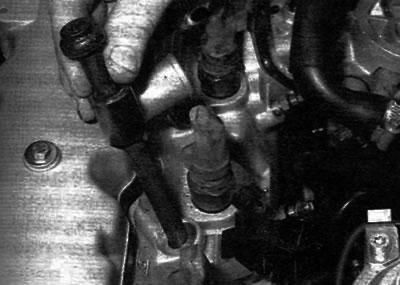
Pic. 13.20. Unscrewing the cylinder head bolt and removing the remote element
21. Separate a head of cylinders from the block of cylinders and an adjusting pin, swinging it. The Peugeot/Citroen special tool for this procedure consists of two metal rods with ends bent at right angles (pic. 13.21). Do not pry with makeshift levers inserted between the mating surfaces of the head and cylinder block, as this may damage the surfaces under the gasket.
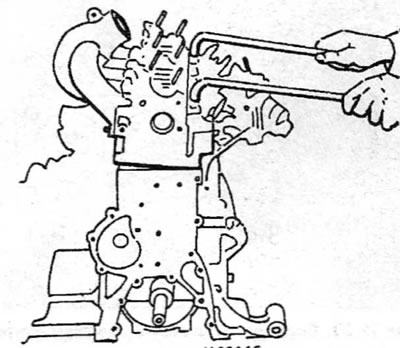
Pic. 13.21. Removing the cylinder head with bent rods
22. Remove the cylinder head from the block and remove the gasket (pic. 13.22).
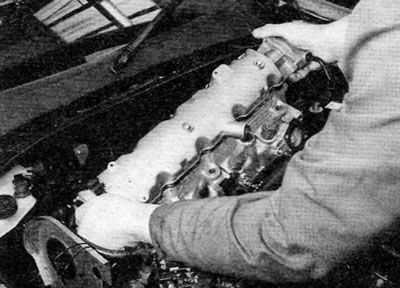
Pic. 13.22. Removing the cylinder head
Preparing for installation
23. Before installing the cylinder head, thoroughly clean the mating surfaces of the cylinder head and cylinder block/crankcase. The manufacturer recommends the use of a special detergent for this purpose, but an acceptable result in removing all traces of gasket and carbon can be achieved with a hard plastic or wooden scraper. The same method can be used to clean piston crowns. Be very careful not to scratch or otherwise damage the mating surfaces of the cylinder block and cylinder head when cleaning, as the aluminum alloy can be easily damaged. Then make sure that carbon deposits do not get into the lubrication channels and channels of the cooling system. This is especially important for the lubrication system, as deposits can block the oil supply to engine components. Use adhesive tape and paper to cover the oil passages, coolant passages, and bolt holes in the cylinder block/engine parquet. To prevent the removed carbon from getting into the gaps between the pistons and the cylinder walls, put a little grease into the gap, after cleaning each piston, take a small brush and remove all traces of grease and carbon from the gap, then wipe everything with a clean rag.
24. Check the mating surfaces of the cylinder block/crankcase and cylinder head for nicks, deep scratches and other damage. If they are minor, they can be carefully removed with a file. If they are large, the only alternative to replacement is machining. If deformation of the cylinder head mating surface is suspected (under the gasket), check this surface with a ruler. If necessary, contact chapter 2D.
25. Thoroughly clean the threads of the holes for the cylinder head bolts in the cylinder block. Make sure the bolts turn freely and all traces of oil and water are removed from each bolt hole.
Gasket selection
26. Make sure that the timing belt is removed from the high pressure fuel pump sprocket, and then turn the crankshaft so that pistons No. 1 and 4 are at TDC. Install a dial indicator on the cylinder block and zero the scale by bringing the indicator plunger to the mating surface of the block. Move the plunger to the center of the No. 1 piston, and then slowly rotate the crankshaft back and forth to bring the piston past TDC while observing the highest reading on the indicator scale. Record this reading.
27. Repeat this procedure on piston number 4, and then rotate the crankshaft a half turn (180°) and repeat the procedure on pistons No. 2 and 3 (pic. 13.27).
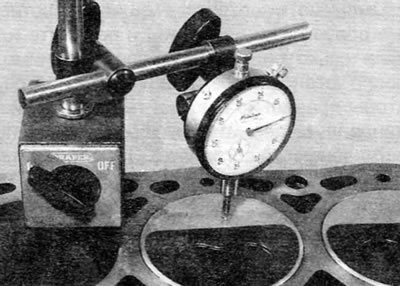
Fig.13.27 Piston protrusion measurement
28. In the absence of a dial gauge, piston protrusion can be measured using a ruler and «fan» feeler gauge or with a caliper. However, this is less accurate and therefore not recommended.
29. Record the largest piston protrusion and use it to select the correct cylinder head gasket From the following table. Notches or holes in the corner of the gasket are used to identify the thickness. Slots or holes near the centerline of the gasket indicate the power and type of engine and have no bearing on determining the thickness of the gasket (pic. 13.29).
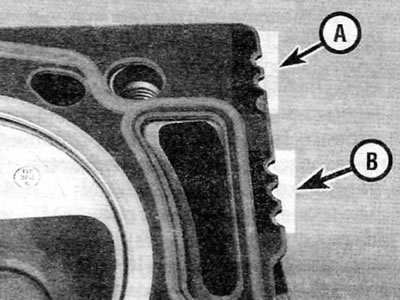
Pic. 13.29. Identification slots for identifying the thickness of the cylinder head gasket (A). Also pay attention to the grooves for identifying the displacement and engine type (IN)
Piston protrusion
- 0.56 - 0.67 mm
- 0.68 - 0.71 mm
- 0.79 - 0.75 mm
- 0.76 - 0.79 mm
- 0.80 - 0.83 mm
Gasket identification
- 1 groove
- 9 groove
- 3 slots
- 4 slots
- 5 slots
Inspection of cylinder head bolts
30. On XUD engines, various types of cylinder head bolts were used during the assembly process - with a hex head and with a Tox head. When working with an engine equipped with older hex bolts, these bolts should be replaced with the latest Tox bolts after they are unscrewed. Togh bolts are available in two versions. One version has a guiding tip at the base of the thread, and the other version has no tip. Torx bolts may be reused if their length does not exceed the values given below. Keep in mind that if the bolt is reworked to expose the spacer (see par. 33), the final installation of the cylinder head will require a new bolt.
31. Measure the length of each bolt from the base of the head to the end of the bolt (or end of guide) (pic. 13.31). Compare the results with the values shown in the following table to determine if the bolts and spacers need to be replaced.
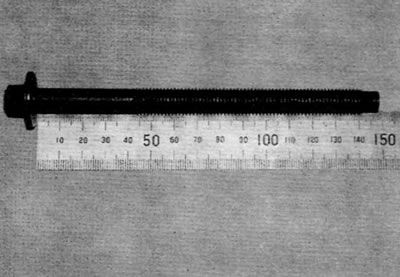
Fig.13.31. Measure bolt length to determine if replacement is required
Note. Given the stresses that occur in the cylinder head bolts, it is strongly recommended to replace them, regardless of their external condition.
Bolt length — Required action
Bolts without guide tip:
- Less than 131.5mm - Reuse bolts/spacers
- Greater than 131.5 mm - Replace bolts/spacers
Head bolts:
- Less than 135.5mm - Reuse bolts/spacers
- Greater than 135.5 mm - Replace bolts/spacers
Installation
32. Turn the crankshaft clockwise (viewed from the timing belt side) until pistons #1 and #4 are past bottom dead center (NMT) and began to rise, and then position them in the middle of the upward stroke. Pistons #2 and #3 will also be in the middle of their stroke, but downstroke.
33. Install the gasket correctly on the cylinder block so that the identification slots or holes are on the flywheel/plank side of the engine. Make sure there is a dowel pin in place: at the end of the cylinder block where the timing belt is located. Be aware that due to the presence of only one locating pin, the gasket may move when installing the cylinder head (due to engine tilt), especially when the cylinder head is installed on the engine without removing it from the vehicle. In the worst case, the pistons and/or valves can hit the gasket causing engine damage. To avoid this problem, cut off the head from «old» cylinder head bolt and saw through the slot on the end of the bolt so that the bolt can be turned with a screwdriver. Insert a bolt into one of the bolt holes on the end of the engine block where the flywheel is located, and then align the gasket using the bolt and dowel pin. This will hold the gasket in place when installing the cylinder head.
34. Lower the cylinder head onto the block.
35. Apply a little grease to the threads and to the back of the heads of the cylinder head bolts. Peugeot/Citroen recommends Molykote G Rapid Plus (can be purchased from a dealer). If the prescribed lubricant is not available, any good quality high temperature lubricant can be used.
36. Carefully insert each bolt with the corresponding spacer (convex side up, if applicable) into the appropriate hole (don't let them fall) and screw them in by hand only. If applicable, after installing three or four bolts, in order to correctly align the cylinder head, remove the modified bolt, installed according to item 33, and screw in a new bolt in its place.
37. Working gradually and in the prescribed sequence, using a torque wrench and a suitable end head, tighten the cylinder head bolts to the prescribed torque according to stage 1 (pic. 13.37).
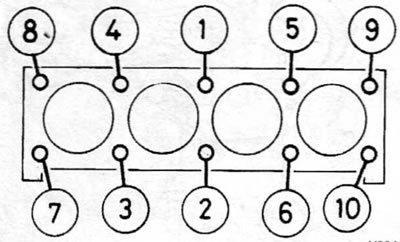
Fig.13.37. Cylinder head bolt tightening sequence
38. After tightening all the bolts according to step 1, working again in the same sequence, tighten each bolt to the prescribed torque according to step 2. Finally, tighten the bolts to the specified angle according to step 3. To ensure accuracy, it is recommended to use a goniometer at this stage of tightening.
39. The rest of the installation is carried out in the reverse order of removal, taking into account the following points:
- A) Route the electrical wiring correctly and connect the appropriate electrical connectors securely.
- b) Connect the coolant hoses correctly and tighten the appropriate clamps securely.
- V) Connect all vacuum/vent hoses correctly.
- G) Install the cylinder head cover as described in paragraph 4.
- d) Connect the exhaust system to the manifold, install the air filter housing and air lines, and adjust the accelerator cable as described in chapter 4B. If the manifolds have been removed, install them as described in chapter 4B.
- e) Charge the cooling system as described in chapter 1B.
- and) Connect the battery and bleed the fuel system as described in chapter 4B.
